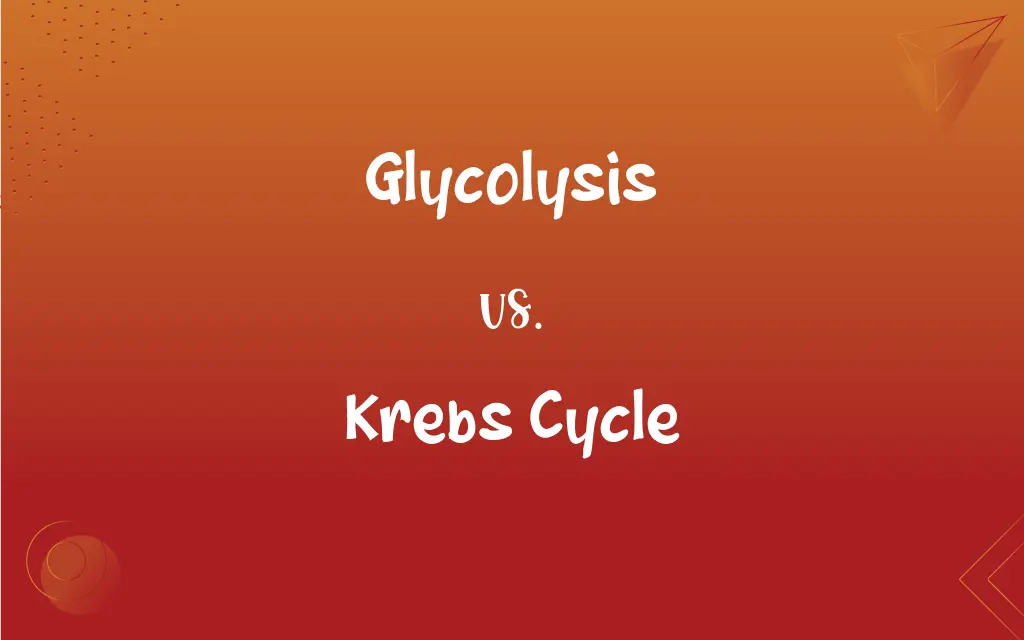Glycolysis vs. Krebs Cycle: What's the Difference?
Edited by Janet White || By Harlon Moss || Updated on October 17, 2023
Glycolysis is the metabolic pathway breaking glucose into pyruvate; the Krebs cycle processes acetyl-CoA to produce ATP, CO₂, and NADH.

Key Differences
Glycolysis is the initial step of glucose metabolism, wherein glucose is broken down into pyruvate. The Krebs cycle, on the other hand, is a series of reactions that occur in the mitochondria and produce ATP, NADH, and CO₂. Both pathways are central to cellular respiration, but they function at different stages and locations.
Glycolysis takes place in the cytoplasm of the cell, converting one molecule of glucose into two molecules of pyruvate. The Krebs cycle, however, operates within the mitochondria, oxidizing acetyl-CoA derived from pyruvate, fats, and amino acids, to generate energy.
In glycolysis, the net gain is two ATP molecules and two NADH molecules for each glucose. The Krebs cycle yields more energy: one ATP, three NADH, and one FADH₂ per acetyl-CoA.
The importance of glycolysis is evident in that it can occur under both aerobic and anaerobic conditions. The Krebs cycle, however, strictly requires oxygen, as it's an aerobic process.
Both glycolysis and the Krebs cycle are interconnected. Pyruvate from glycolysis is transported into the mitochondria and is decarboxylated to form acetyl-CoA, which then enters the Krebs cycle.
ADVERTISEMENT
Comparison Chart
Location
Occurs in the cytoplasm.
Takes place within the mitochondria.
Starting Molecule
Begins with glucose.
Begins with acetyl-CoA.
Products
Produces pyruvate, 2 ATP, and 2 NADH.
Produces 2 CO₂, 3 NADH, 1 FADH₂, and 1 ATP per cycle.
Oxygen Requirement
Can occur under both aerobic and anaerobic.
Strictly aerobic.
Relation to Other
Initial step in glucose metabolism.
Follows glycolysis; processes pyruvate to acetyl-CoA.
ADVERTISEMENT
Glycolysis and Krebs Cycle Definitions
Glycolysis
The breakdown of glucose to pyruvate.
The cell gains energy through glycolysis by converting glucose to pyruvate.
Krebs Cycle
A major pathway in carbohydrate, fat, and protein metabolism.
Fats and amino acids can also enter the Krebs cycle after being converted to acetyl-CoA.
Glycolysis
A metabolic pathway occurring in the cytoplasm.
Glycolysis plays a crucial role in providing energy in the absence of oxygen.
Krebs Cycle
A series of chemical reactions used by cells to produce energy.
The Krebs cycle is essential for the complete oxidation of glucose.
Glycolysis
The anaerobic conversion of glucose.
In the absence of oxygen, cells use glycolysis to generate ATP.
Krebs Cycle
An aerobic process occurring in mitochondria.
Oxygen is a prerequisite for the Krebs cycle to function effectively.
Glycolysis
The precursor pathway to the Krebs cycle and oxidative phosphorylation.
Pyruvate generated from glycolysis is further processed in the Krebs cycle.
Krebs Cycle
The cycle that oxidizes acetyl-CoA to CO₂ and H₂O.
The Krebs cycle generates ATP, NADH, and FADH₂ as energy carriers.
Glycolysis
A ten-step process producing ATP and NADH.
During vigorous exercise, muscles primarily rely on glycolysis for energy.
Krebs Cycle
A central component of cellular respiration.
After glycolysis, the Krebs cycle is the next step in glucose oxidation.
Glycolysis
A metabolic process that occurs in nearly all living cells in which glucose is converted in a series of steps to pyruvic acid and during which energy is released in the form of ATP.
Glycolysis
(biochemistry) The cellular degradation of the simple sugar glucose to yield pyruvic acid, and ATP as an energy source
Glycolysis
A metabolic process that breaks down carbohydrates and sugars through a series of reactions to either pyruvic acid or lactic acid and release energy for the body in the form of ATP
FAQs
How is glycolysis related to the Krebs cycle?
Pyruvate from glycolysis is processed to form acetyl-CoA, which enters the Krebs cycle.
What is the main product of glycolysis?
The main product of glycolysis is pyruvate.
Where does glycolysis occur?
Glycolysis occurs in the cytoplasm of the cell.
What is glycolysis?
Glycolysis is the metabolic pathway that breaks glucose into pyruvate.
Can glycolysis function without oxygen?
Yes, glycolysis can function both aerobically and anaerobically.
Where does the Krebs cycle take place?
The Krebs cycle occurs in the mitochondria.
How many ATP molecules does glycolysis produce?
Glycolysis produces a net gain of two ATP molecules.
What happens to the pyruvate produced in glycolysis?
Pyruvate is transported to the mitochondria and processed to acetyl-CoA for the Krebs cycle.
Which produces more ATP, glycolysis or the Krebs cycle?
While glycolysis produces 2 ATPs, the Krebs cycle and subsequent oxidative phosphorylation produce a greater amount of ATP.
What molecules can feed into the Krebs cycle?
Acetyl-CoA derived from carbohydrates, fats, and amino acids can feed into the Krebs cycle.
Why is glycolysis considered anaerobic?
Because it can function without the presence of oxygen.
What is the Krebs cycle?
The Krebs cycle is a series of reactions that produce ATP, CO₂, and NADH from acetyl-CoA.
How are glycolysis and the Krebs cycle interconnected?
Pyruvate from glycolysis is transformed into acetyl-CoA, which enters the Krebs cycle.
How does the Krebs cycle begin?
The Krebs cycle begins with the combination of acetyl-CoA with oxaloacetate.
How is the energy produced in the Krebs cycle stored?
The energy is stored in molecules like ATP, NADH, and FADH₂.
What is the main purpose of the Krebs cycle?
The main purpose is to generate energy carriers like ATP, NADH, and FADH₂.
Are both glycolysis and the Krebs cycle parts of cellular respiration?
Yes, both processes are integral parts of cellular respiration.
Does the Krebs cycle require oxygen?
Yes, the Krebs cycle is an aerobic process and requires oxygen.
Can the Krebs cycle operate without glycolysis?
While the Krebs cycle can process other molecules, glycolysis provides a significant input through pyruvate.
Is the Krebs cycle also known by another name?
Yes, it's also called the citric acid cycle or the TCA cycle.
About Author
Written by
Harlon MossHarlon is a seasoned quality moderator and accomplished content writer for Difference Wiki. An alumnus of the prestigious University of California, he earned his degree in Computer Science. Leveraging his academic background, Harlon brings a meticulous and informed perspective to his work, ensuring content accuracy and excellence.
Edited by
Janet WhiteJanet White has been an esteemed writer and blogger for Difference Wiki. Holding a Master's degree in Science and Medical Journalism from the prestigious Boston University, she has consistently demonstrated her expertise and passion for her field. When she's not immersed in her work, Janet relishes her time exercising, delving into a good book, and cherishing moments with friends and family.































































